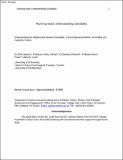Files in this item
Understanding the relationship between suicidality, current depressed mood, personality, and cognitive factors
Item metadata
| dc.contributor.author | Cameron, Shri | |
| dc.contributor.author | Brown, Verity J. | |
| dc.contributor.author | Dritschel, Barbara | |
| dc.contributor.author | Power, Kevin | |
| dc.contributor.author | Cook, Malcolm | |
| dc.date.accessioned | 2018-03-12T00:33:30Z | |
| dc.date.available | 2018-03-12T00:33:30Z | |
| dc.date.issued | 2017-12 | |
| dc.identifier | 249694840 | |
| dc.identifier | a7bd19cf-3cd9-4be7-879c-a3fd1ac55343 | |
| dc.identifier | 85015239511 | |
| dc.identifier | 000415053500002 | |
| dc.identifier.citation | Cameron , S , Brown , V J , Dritschel , B , Power , K & Cook , M 2017 , ' Understanding the relationship between suicidality, current depressed mood, personality, and cognitive factors ' , Psychology and Psychotherapy: Theory, Research and Practice , vol. 90 , no. 4 , pp. 530-549 . https://doi.org/10.1111/papt.12123 | en |
| dc.identifier.issn | 2044-8341 | |
| dc.identifier.other | Bibtex: urn:9ce41908c97d4b3031dfff41373b561e | |
| dc.identifier.other | ORCID: /0000-0001-5762-1797/work/63380690 | |
| dc.identifier.other | ORCID: /0000-0002-0909-6323/work/64698256 | |
| dc.identifier.uri | https://hdl.handle.net/10023/12897 | |
| dc.description.abstract | Objectives: Links between suicidality and depressed mood are well established. There is, however, little information about the emotional regulation processes that underlie the relationship between suicidality and current low mood, and how these processes differ between groups of never-suicidal (NS), suicidal ideators, and suicide attempters. As suicidality and depression are heterogeneous constructs, this study aimed to conduct within- and between-group comparisons of known suicide risk factors that are associated with emotion regulation (neuroticism, trait aggression, brooding, impulsivity, and overgeneral autobiographical memories). Design: Correlational design using between- and within-group comparisons from self-report measures. Methods: Inter- and intragroup differences were identified using Pearson's correlation coefficients and tests of difference. An analysis of indirect effects was used to investigate whether the relationship between suicidality and current low mood was mediated by neuroticism, trait aggression, brooding, impulsivity, and overgeneral autobiographical memories, and if this relationship varied according to group type. Results: Brooding appeared to be a consistent feature of all three groups and was closely related to current low mood. Compared to the NS group, the relationship between suicide attempts and current low mood showed greater associations with brooding, trait aggression, and overgeneral autobiographical memories. Compared to the NS group, the suicidal ideation group showed stronger associations with neuroticism and impulsivity, but these factors did not correlate with low mood. Conclusion: These results suggest a need for larger studies to focus on heterogeneity within suicidal populations and consider how different combinations of risk factors may heighten or reduce suicide risk. Practitioner points: * It is well known that the severity and intensity of suicide and depressed presentations vary because of underlying dispositional and contextual factors (Fried & Nesse, ) which, in turn, affect how events are interpreted and responded to. Despite this, there is little research about how these mechanisms operate in different types of suicide groups, and their influence on the relationship between suicidality and current low mood. * Understanding interrelationships that affect current low mood is of clinical significance because past suicidal history and deteriorations in already negative mood are linked to repeated suicide attempts and completion. * Our findings show that ruminative brooding, defined as a tendency to repeatedly think about emotional aspects of an event, consistently correlates with current low mood across different types of suicidal groups (NS, suicidal ideators, and suicide attempters), and across analyses. * Findings also show that suicidal ideation and attempt groups were associated with specific personality characteristics that increased the propensity of emotional responding and interpretation compared to the NS group. The relationship between suicide attempt and current low mood had a higher propensity to be influenced by trait aggression, brooding, and overgenerality compared to the NS group. In contrast, although the suicidal ideation group correlated more strongly with neuroticism and impulsivity, these factors did not influence current low mood. * In terms of clinical practice, these findings imply that specific styles of interpretation and thinking may maintain the relationship between suicidality and current low mood. Given the cross-sectional nature of the study, however, it is not possible to imply causality. Nevertheless, the findings obtained provide some support for transdiagnostic models of cognitive-behavioural processes that could be developed further. | |
| dc.format.extent | 462644 | |
| dc.language.iso | eng | |
| dc.relation.ispartof | Psychology and Psychotherapy: Theory, Research and Practice | en |
| dc.subject | Suicide | en |
| dc.subject | Trait aggression | en |
| dc.subject | Impulsivity | en |
| dc.subject | Neuroticism | en |
| dc.subject | Rumination | en |
| dc.subject | BF Psychology | en |
| dc.subject | E-NDAS | en |
| dc.subject | SDG 3 - Good Health and Well-being | en |
| dc.subject.lcc | BF | en |
| dc.title | Understanding the relationship between suicidality, current depressed mood, personality, and cognitive factors | en |
| dc.type | Journal article | en |
| dc.contributor.institution | University of St Andrews. School of Psychology and Neuroscience | en |
| dc.contributor.institution | University of St Andrews. Institute of Behavioural and Neural Sciences | en |
| dc.identifier.doi | https://doi.org/10.1111/papt.12123 | |
| dc.description.status | Peer reviewed | en |
| dc.date.embargoedUntil | 2018-03-11 |
This item appears in the following Collection(s)
Items in the St Andrews Research Repository are protected by copyright, with all rights reserved, unless otherwise indicated.

